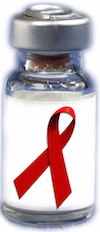
Over the past half century, hundreds of millions of doses of “killed-virus” vaccines have protected people from deadly diseases such as polio, influenza, and rabies. It is one of history's most established methods for producing safe, effective vaccines.
Incredibly, it hasn't been tested for HIV/AIDS.
A philanthropist with the right mix of courage and common sense can change that.
Hear from the Scientists
3-Minute Version (Full video here)
In This Video
How can this be true?
Given the devastation that HIV/AIDS has caused around the globe for over 30 years, it is difficult to grasp how one of the best-established vaccine methods has been omitted from the entire AIDS research agenda. The short answer is that killed-virus vaccines have simply slipped through the cracks between the primary entities engaged in HIV vaccine research.
Biotech companies have seen no profit potential in vaccines based on old-fashioned public sector technology. For their part, academic scientists can get no support for product development based on “old-school” science as opposed to seeking innovative methods based on new scientific understanding. And the few practical vaccinologists interested in classical methods have never been able to obtain significant funding for killed-virus vaccine development from any of the traditional sources.
So while it never has been anyone’s explicit policy to omit one of the most historically-successful vaccine methods for HIV/AIDS, in effect, that has been the outcome.
Read more details and Frequently-Asked Questions (FAQs)
The Opportunity
A small but determined group of public health and vaccine experts — including vaccinologist Burt Dorman — have persisted over countless years in their efforts to advocate for the killed-virus approach. To date, that advocacy has largely occurred using traditional methods, directed towards traditional entities.
Recently, however, we have assembled an effort to pursue an entirely new opportunity — namely the support of individual philanthropists with enough resources to fund the project, enough backbone to stand up to potential naysayers, and enough common sense to understand that such a straightforward and well-understood solution deserves its day in the laboratory.
Within a handful of years, with a relatively small amount of funding, we can definitively assess whether a killed-virus vaccine can stop the AIDS pandemic. While no experienced vaccinologist would guarantee that any approach will definitively work, experts in the killed-virus method think that it very well might. Some are optimistic — even confident — that it will.
Fortunately, there is no need to speculate. We can do the experiments and find out.
This situation calls for a visionary philanthropic hero — one whose investment which may literally and dramatically change the course of history. We know that person is out there. Our task is to get this remarkable opportunity onto that person’s radar screen.